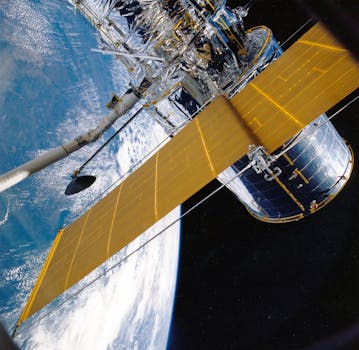The Future of Satellites: Revolutionizing Global Communication and Exploration

The Future of Satellites: Revolutionizing Global Communication and Exploration. The future of satellites is an exciting and rapidly evolving field, with new technologies and innovations emerging every day. Satellites have been a crucial part of our daily lives for decades, providing us with navigation, communication, and weather forecasting capabilities. However, the future of satellites holds even more promise, with the potential to transform the way we live, work, and interact with each other.
One of the most significant advancements in satellite technology is the development of small satellites, also known as CubeSats. These tiny satellites are approximately the size of a shoebox and weigh less than 3 pounds, making them much cheaper and easier to launch than traditional satellites. Small satellites have the potential to revolutionize the satellite industry, enabling the creation of constellations of thousands of satellites that can provide global coverage and connectivity.
Another area of innovation in the satellite industry is the development of reusable launch vehicles. Companies like SpaceX and Blue Origin are working on creating rockets that can launch satellites into orbit and then return to Earth, reducing the cost of access to space and making it more sustainable. This technology has the potential to significantly reduce the cost of launching satellites, making it more accessible to companies and organizations around the world.
The future of satellites also holds tremendous potential for scientific research and exploration. Satellites are being used to study the Earth’s climate, monitor natural disasters, and explore the universe. For example, the NASA’s Transiting Exoplanet Survey Satellite (TESS) is a space telescope that is designed to discover new exoplanets and study the properties of distant stars. The European Space Agency’s Gaia mission is another example, which is creating a highly accurate 3D map of the Milky Way galaxy.
In addition to these advancements, satellites are also playing a critical role in the development of the Internet of Things (IoT). The IoT is a network of physical devices, vehicles, and other items that are embedded with sensors, software, and connectivity, allowing them to collect and exchange data. Satellites are being used to provide connectivity to IoT devices in remote and underserved areas, enabling the creation of new applications and services such as smart agriculture, smart cities, and smart transportation.
Advances in Satellite Technology
Advances in satellite technology are driving the growth and development of the satellite industry. One of the most significant advancements is the development of high-throughput satellites (HTS), which are designed to provide high-speed internet connectivity to users around the world. HTS satellites use a combination of advanced technologies, including spot beams and frequency reuse, to provide high-capacity connectivity at a lower cost per bit.
Another area of innovation is the development of satellite-based navigation systems. The Global Positioning System (GPS) is a network of satellites that provides location information to GPS receivers on the ground. However, other countries are also developing their own satellite-based navigation systems, such as the European Union’s Galileo system and China’s Beidou system. These systems provide more accurate and reliable location information, and are being used for a wide range of applications, including aviation, maritime, and land transportation.
The use of artificial intelligence (AI) and machine learning (ML) is also becoming more prevalent in the satellite industry. AI and ML algorithms are being used to analyze the vast amounts of data generated by satellites, and to improve the efficiency and effectiveness of satellite operations. For example, AI-powered systems can be used to predict and prevent satellite failures, and to optimize the transmission of data from satellites to ground stations.
Challenges and Opportunities
Despite the many advances and innovations in the satellite industry, there are also challenges and opportunities that need to be addressed. One of the biggest challenges is the issue of space debris, which is a growing concern for the satellite industry. Space debris refers to the accumulation of defunct satellites, rocket parts, and other objects in Earth’s orbit, which can pose a risk to operational satellites and other space-based assets.
Another challenge is the need for more sustainable and environmentally friendly launch technologies. The launch of satellites into space requires a significant amount of energy, and the production of rocket fuel can have negative environmental impacts. Therefore, there is a need for more sustainable and environmentally friendly launch technologies, such as reusable launch vehicles and electric propulsion systems.
Despite these challenges, the future of satellites holds tremendous opportunities for innovation and growth. The use of satellites is becoming more widespread and diverse, with new applications and services emerging every day. For example, satellites are being used to provide connectivity to remote and underserved areas, to monitor and track natural disasters, and to study the Earth’s climate and environment.



